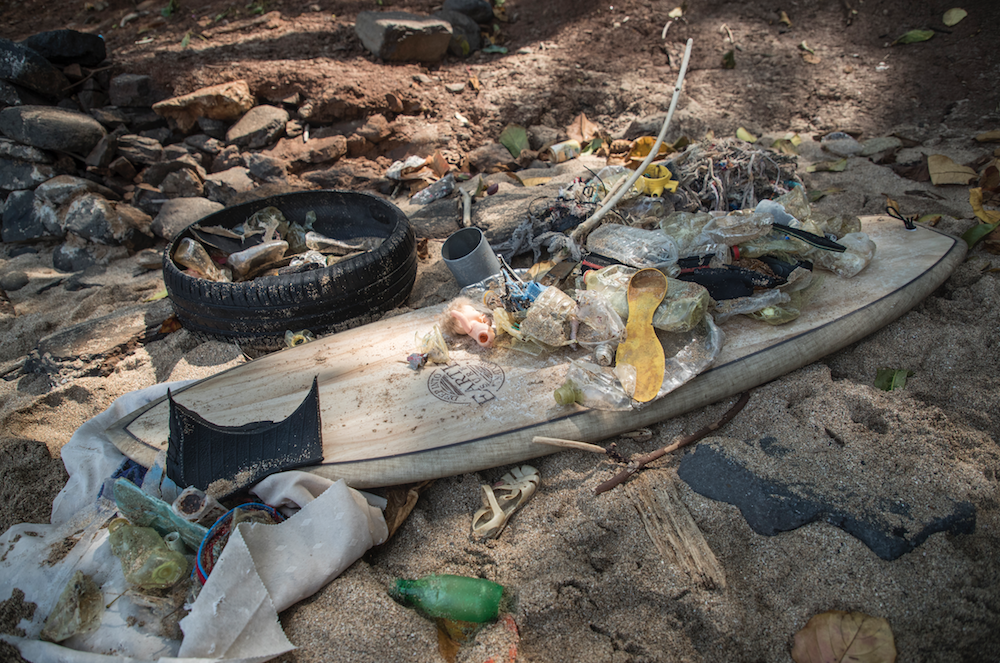More Paddlesport manufacturers are looking at the bigger picture. No longer are we asking the question, “What can I do for the environment,” but are taking action, inspiring a visible shift in manufacturing environmentally-friendlier products in a more sustainable way.
While paddle sports brings us closer to nature, they don’t always bring us closer to taking care of the environment. But they can.
You don’t need to collect waste to benefit the environment, just recycle your own HDPE.
One example is washing up on shores around the globe. The severity of plastic trash and debris in his native Great Britain motivated Rob Thompson to found Odyssey Innovation, an initiative focused on collecting and recycling marine waste plastic, turning it into kayaks and other products. Thompson, who partnered with Palm Equipment and Islander Kayaks to bring his idea to life, wanted to create a product that could be used to access otherwise inaccessible places to collect more trash, and therefore make more kayaks, which could be used to gather more trash, ultimately contributing to a positive rather than negative cycle of influence. The Islander Odyssey debuted this year at PADDLEexpo with resounding success.
You don’t need to collect waste to benefit the environment, just recycle your own HDPE. In 2018, Tahe Outdoors released their new three-layer E-co:re lay-up, the inner shell of which is made out the plastic waste that comes from producing kayaks. “Instead of throwing the PE waste and low-quality PE kayak shells away, we recycle them,” explains Marian Salmitsu. The plastic waste is first cleaned and prepared, then shredded into small pellets. The shredded mixture is “re-used” to make the inner layer of the new kayak. As it is actually more cost effective to recycle HDPE than it is to manufacture ‘virgin’ plastic, Tahe’s E-Co:re model is a win for the consumer, the manufacturer, and the environment.
The Britain-based Pyranha, who also manufacture P&H Sea Kayaks, Venture and Rebel, have been re-granulating and recycling waste polyethylene since the mid 90s. “We’re playing our part by continuing to recycle offcuts from other industries in our boat padding and our famous fish sponge, reducing usage through industry-leading efficient machinery, offering reduced packaging where appropriate, and recycling waste from production processes and end-of-life products,” says Marketing Manager Mathew Wilkinson.
it is actually more cost effective to recycle HDPE than it is to manufacture ‘virgin’ plastic
Another trend towards the environment is the shift away from PVC in the production of inflatables. Polyvinyl chloride (PVC), also known as vinyl or #3 plastic, while affordable, is widely recognized as “uniquely toxic among plastics because of its highly toxic ingredients, which readily migrate into the environment during its production, its use, and its disposal.” (The Center For Health, Environment, and Justice).
Instead of PVC, the Czech company Gumotex manufactures boats using their own rubber-based material known as Nitrilon, made in-house from both natural and synthetic rubbers. In fact, Gumotex has been using and developing rubber-based technology rather than PVC since 1956. The German company Grabner also has long-touted the advantages of rubber over PVC.
Not only are rubber-based boats like Graber’s Escape and the Gumotex Thaya better for the environment from production to their afterlife, but they are also usually more durable and longer lasting. “With proper storage and care rubber boats are still in good condition after 20 – 25 years,” asserts Wolfgang Grabner. In contrast, PVC boats lose the plasticizer they contain over the years, causing them to crack and become brittle. Other advantages? Rubber boats are compact and lightweight, stay soft and supple even at frigid temperatures, and can easily be repaired in case of damage. For PVC boats, repair is usually only possible in specialist workshops, especially in the case of significant damage.
Another trend towards the environment is the shift away from PVC in the production of inflatables.
SUP manufacturers are also seeking PVC alternatives, from Bamboo to Coco Flax fibers. The NSP Allrounder Cocoflax, which debuted at PADDLEexpo, uses flax fibers and coconut husks sourced from an organic farm who manufacture coconut water. Bic’s Earth SUP uses a combination of cork, paulownia wood, and flax fiber, which Benoit Treguilly calls “Nature’s Kevlar,” as it has similar flex and tensile strength, but is more durable. It’s not just PVC that causes problems. Bic has also gone varnish-free in their Earth SUPS, which are made using a production process that is “more respectful of sustainable development by minimizing the use of fossil fuels, painting and toxic resins.” In their Fly Eco, Fanatic SUP has sought to eliminate PVC by using a layer of cork on the deck instead, flax fibers, wood veneer, and chosen Sicomin’s GreenPoxy® Bio Resin.
“With EARTH we’ve made the pledge to be better,” says Benoit Treguilly of Bic SUP. One of Grabner’s stated principles is that “Everything generated must be in harmony with the environment.” They clarify; “This begins with the meaningful use of raw material, extends to humane production, environmentally friendly application and realistic recycling or disposal.” Their attitude no-longer belongs to the ‘hippies’ and ‘tree-huggers,’ but is taking root.
To see more consumers and manufactures start to care what their boards and boats are made out of, and how they are made, is a huge step in the right direction. However, we do not want to be blinded by the rising tide, or be too quick to congratulate ourselves just yet. In our hunt to appear more environmentally friendly, the question if we are actually succeeding remains.
“The rise in awareness and a desire for environmentally sustainable products is generally good news, but we do find it frustrating to see cases where sensational statements and actions are made purely for marketing purposes, with no real value in terms of sustainability,” critiques Pyranha’s Wilkinson. And, while products claim to be environmentally friendly, the process with which they are manufactured and shipped is often not.
Wolfgang adds, “We will see in the future whether more manufactures of PVC welded boats return to real rubber. We don’t suppose it will happen soon, because producing rubber boats is much more difficult, complicated and expensive than PVC.”
It will be up to us to determine if the cost of going green- and protecting our future- is one we are willing to pay for.


